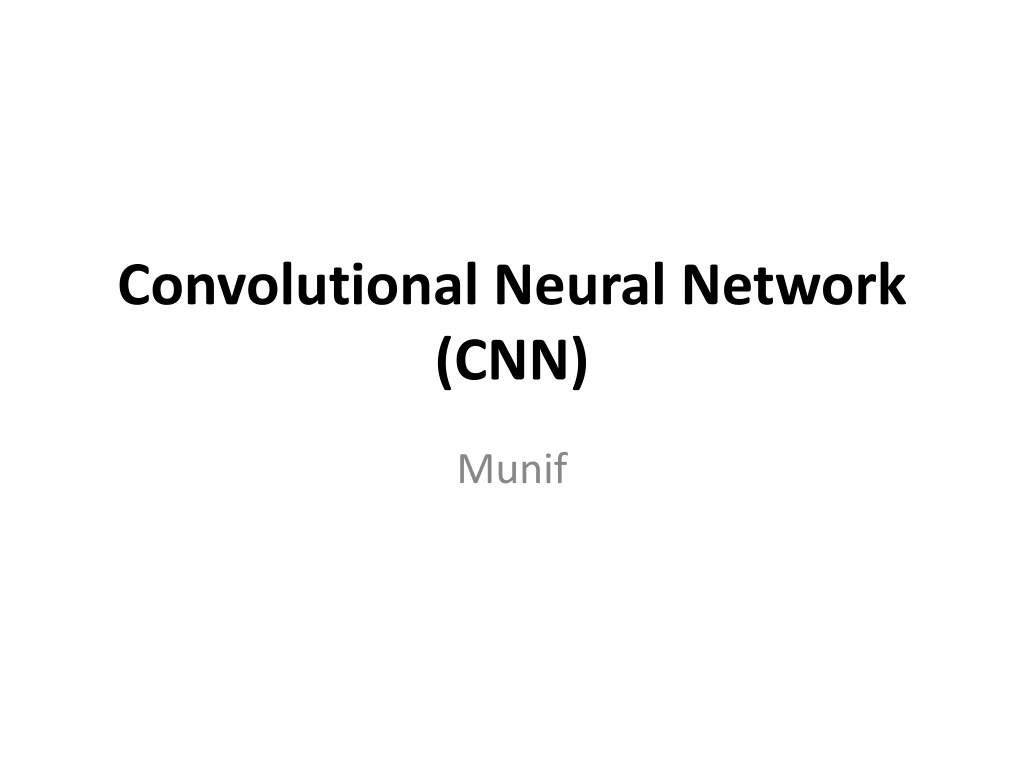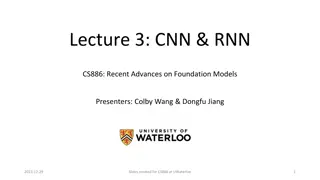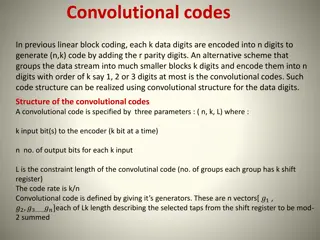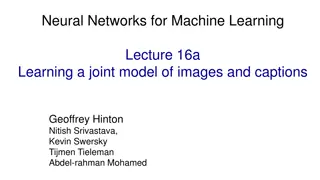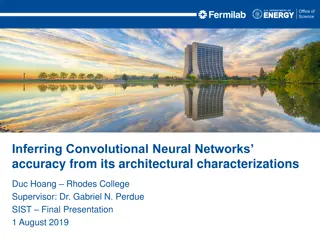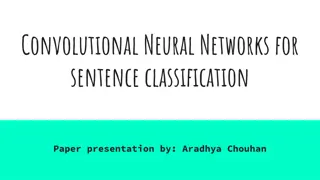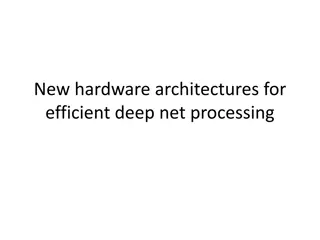Understanding Convolutional Neural Networks (CNN) in Depth
CNN, a type of neural network, comprises convolutional, subsampling, and fully connected layers achieving state-of-the-art results in tasks like handwritten digit recognition. CNN is specialized for image input data but can be tricky to train with large-scale datasets due to the complexity of replicating weights. The architecture of CNN varies based on data characteristics, with models like LeNet proposed by Yann LeCun. The network design involves distinctive features such as convolution layers, pooling layers, and connections between layers known as receptive fields.
Download Presentation

Please find below an Image/Link to download the presentation.
The content on the website is provided AS IS for your information and personal use only. It may not be sold, licensed, or shared on other websites without obtaining consent from the author. Download presentation by click this link. If you encounter any issues during the download, it is possible that the publisher has removed the file from their server.
E N D
Presentation Transcript
Convolutional Neural Network (CNN) Munif
CNN The (CNN) consists of: Convolutional layers Subsampling Layers Fully connected layers Has achieved state-of-the-art result for the recognition of handwritten digits
Neural Network And CNN CNN has fewer connections Replicating Weights Easier to train reduce the training time. A large-scale datasets input are images ( 2D ) CNN tricky to train
Convolution - The new size after convolution! Adapted from: http://deeplearning.stanford.edu/wiki/index.php/File:Convolution_schematic.gif
Pooling ( down sampling ) 2 2 4 4 2 4 8 4 4 4 4 1 6 10 3 4 Mean Pooling Max pooling 4 8 2.5 5 10 4 6 3 - The new size after pooling!
Convolutional Layer Has feature maps: has small filters ( weights ) the most common size: (5 * 5) or (3 * 3 ) Has Bias Its size = input size filter + 1 = the size of output of layer - Each feature map has 1 or more inputs
Pooling Layer Has feature maps: perform down-sampling on the input. Each feature map has 1 weight kernel and 1 bias The most common size: 2 2 larger size may remove and throw away too much information Has Bias Its size = input size/2 = size of the output of this layer - Each feature map has 1 input Reduces computation
The architecture of the CNN Vary, mainly depends on the data ( size, type ..etc) (LeNet Models ) proposed by Yann LeCun Other: Multiresolution CNN architecture 1 million YouTube videos annotated with 487 classes http://cs.stanford.edu/people/karpathy/deepvideo/de epvideo_cvpr2014.pdf
The Connections Between Layers These connections are also referred as receptive fields (RF) Custom table connections Random connections Fully connected layers
forward propagation _ If Convolutional Layer Convolve the inputs with the corresponding kernel. Add Bias to the results _ If pooling Layer Down-sampling the inputs. Add Bias to the results _ Apply activation function ( Ex. sigmoid, hyperbolic tangent) _ Fully Connected (NN ) ? A= ( ?=0 ? ?) + ? A= (? ? + ?) Q = F(A) Fully Connected H4 H3 H2 H1 H1 = Convolutional H2 = pooling H3 = Convolutional H4 = Pooling Input
Backpropagation Is almost identical to the Backpropagation algorithm for standard NN. Calculating the delta Error ( D) Updating weight and bias (W) differences weight sharing sub-sampling layers Vector Fully Connected H4 H3 H2 H1 = Convolutional H2 = pooling H3 = Convolutional H4 = Pooling Input
Backpropagation in Convolutional layer: Up-sampling To calculate the delta error of Convolutional layer: do up-sample: To propagate the error from the Subsampling (pooling) layer. Then multiply the result of the Up-sample by the derivative of the activation function. Example: In case of mean pooling: Kron = Kroneckor Tensor Product of two matrices
Backpropagation in Subsampling layer: Calculating Delta: ??= ??+1 ??+1 * ?? ??+1 1 1 1 1 1 1 1 1 0 1 1 1 1 1 1 1 2 6 6 4 ??+1 2 6 6 1 0 1 2 3
Updating Weight Output of last map Q ( l-1) In Convolutional Layer. 1 1 1 1 1 1 1 1 1 1 1 1 10 10 10 10 10 10 Delta (d) * learning rate 10 10 10 1 2 3 4 In Pooling layer, it does not make a big difference.
Convolutional NN Libraries. Theano: http://deeplearning.net/ Facebook AI Research (FAIR): open sources deep-learning modules for Torch Caffe, by student from UC Berkeley Deep Learning Toolbox: By Rasmus http://www.mathworks.com/matlabcentral/fileexchange/38310-deep-learning- toolbox
The MNIST database of handwritten digits Has Training set of 60,000 examples Test set of 10,000 examples The size of each Image 28x28 Can be download from http://yann.lecun.com/exdb/mnist/
Reshape and Prepare Datasets train_x = double(reshape(train_x',28,28,60000))/255; test_x = double(reshape(test_x',28,28,10000))/255; train_y = double(train_y'); test_y = double(test_y');
Define layers of CNN Creating 5 Layers including the input layer. cnn.layers = { struct('type', 'i') %input layer struct('type', 'c', 'outputmaps', 6, 'kernelsize', 5) %convolution layer struct('type', 's', 'scale', 2) %sub sampling layer struct('type', 'c', 'outputmaps', 12, 'kernelsize', 5) %convolution layer struct('type', 's', 'scale', 2) %subsampling layer };
Define the Parameters opts.alpha = 0.1; opts.batchsize = 2; opts.numepochs = 50;
Training and Testing Setting up the network: cnn = cnnsetup(cnn, train_x, train_y); Train_CNN cnn = cnntrain(cnn, train_x, train_y, opts); Test_CNN cnntest(cnn, test_x, test_y);
